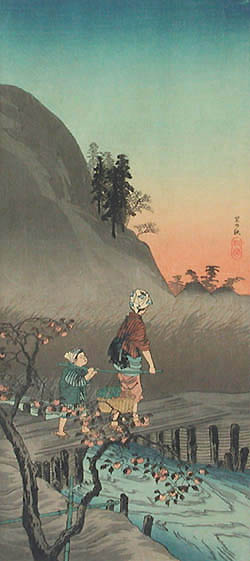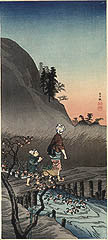| Title: |
Autumn at a Village |
| Artist: |
Shotei, Takahashi (Asakusa, Tokyo, 1871 - Hiroshima, 1945) |
| Date: |
c. 1920 - 1925 |
| Medium: |
Original Japanese Woodcut |
| Publisher: |
Watanabe, Tokyo |
| Note: |
Takahashi Shotei: By 1930 a Renaissance in the art
of the Japanese woodcut had taken place. Referred to simply as 'Shin Hanga'
(the 'New Prints'), the woodcuts created by the great masters of this
era were as splendid as the art of Japan's legendary past masters. The
movement began in Tokyo, largely promoted by the influential publishing
house of Watanabe, and by 1920 the finest artists were commissioned by
him. Goyo and Shinsui produced modern figure studies of timeless beauty.
Landscape and other views, however, attracted most of the talented artists
such as Hasui, Takahashi Shotei, Yoshida, Koitsu Tsuchiya and Shiro Kasamatsu.
With their distinctive styles, these artists were responsible for infusing
new life into the great tradition of the Japanese woodcut. |
| |
The great pioneer of Shin Hanga art, Takahashi Shotei was
the first artist commissioned Watanabe and designed woodcuts for him as
early as 1907. Shotei began his artistic education at the age of nine
when he studied drawing techniques under his uncle, the master painter,
Matsumoto Fuko (1840-1923). Until his successful collaboration with Watanabe,
Takahashi Shotei supported himself mainly as an illustrator for magazines and newspapers. |
| |
Takahashi Shotei's woodcuts were immediately popular (especially with
collectors in Europe and America) and it is estimated that by 1923 he
had created over 500 works of art in this medium. The year 1923, however,
also marked the devastating Tokyo earthquake. The entire inventory of
Shotei's woodblocks and many impressions taken from them were destroyed
in the subsequent fires. Thus unlike the woodcuts of most Shin Hanga artists,
no later re-strikes were pulled from Takahashi Shotei's woodblocks and his prints
today are quite scarce. |
| |
Created in the large Tanzaku size, Autumn at a Village
is known as a long format print. Takahashi Shotei designed his first long format
landscape for Watanabe around 1915 and produced many more in this size
until about 1925. After that date, the artist turned more towards the
traditional oban size woodcut. His long association with Watanabe ended
in 1930 when he left to work with a rival Tokyo publisher, Fusio Gabo.
Takahashi Shotei died in Hiroshima while visiting his daughter in 1945. It is believed
that this great master of the Japanese landscape woodcut was a victim
of the atomic bomb. |
| Size: |
Large Tanzaku (14 1/2 X 6 3/4) (Sizes in inches
are approximate, height preceding width of plate-mark or image.) |
| |
Matted with 100% Archival Materials |
| Condition: |
Printed upon Japanese mulberry (rice) paper and with margins
to the edges of the image as published by Watanabe in Tokyo between 1920
and 1925. Signed in the image by the artist with both his signature and
chop mark. A brilliant impression without a trace of light or time
staining and in excellent condition throughout. Autumn at a Village
represents a prime, original example of the famous landscape art of Takahashi
Shotei. |
| Price: |
Sold - The price is no longer available. |
| Important Information: |
The artist biographies, research and or information pertaining to all the original works of art posted on our pages has been written and designed by Greg & Connie Peters exclusively for our site, (www.artoftheprint.com). Please visit us regularly to view the latest artworks offered for sale. We will soon be posting an update of our most recent research and include the biographical and historical information pertaining to our next collection of original works of art created by artists throughout the centuries. We hope you found the information you were looking for and that it has been beneficial.
Our Gallery, (Art of the Print / www.artoftheprint.com) guarantees the authenticity of every work of art we sell 100%. Full documentation and certification is provided. We offer a wide selection of international fine art dating from the early Renaissance to the contemporary art period. |




![]()
![]() or
phone Greg & Connie (905) 957-6666
or
phone Greg & Connie (905) 957-6666